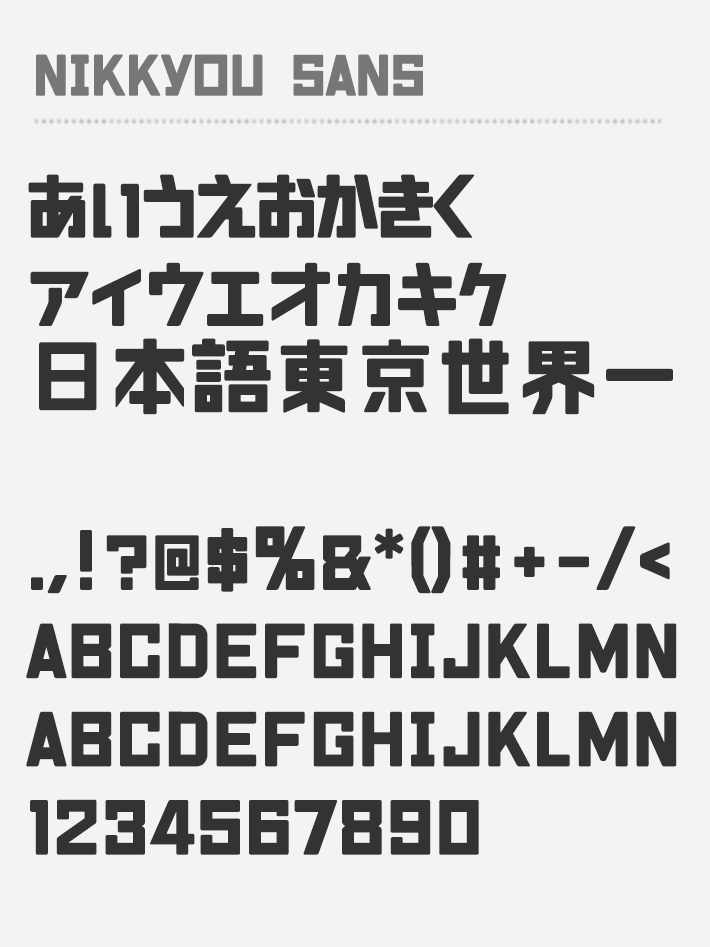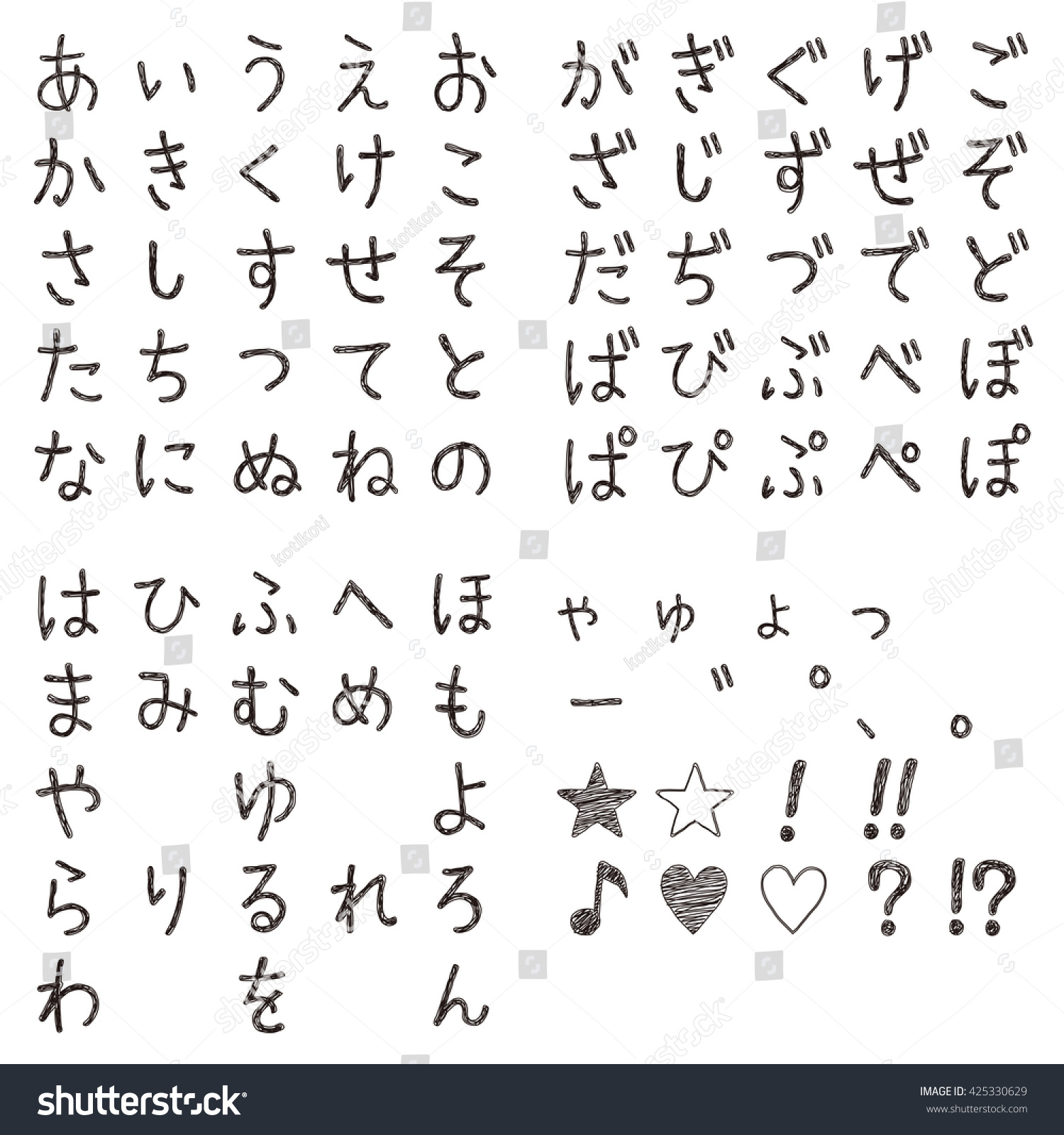Font Hiragana Katakana Kanji
Meiryo, Takeharu Suzuki (Katakana, Hiragana, and Kanji), Tom Rickner (Latin, Greek, and Cyrillic)TrademarkMeiryo is either a registered trademark or a trademark of Microsoft Corporation in the and other countries.Meiryo ( メイリオ, Meirio) is a. Microsoft bundled Meiryo with Office Mac 2008 as part of the standard install, and it replaces as the default system font for on Japanese systems.It was decided that a new Japanese font was needed, as the current ones (mainly and ) are incompatible with Microsoft's technology : Meiryo is intended to increase legibility of characters on. Has been available in Windows for Latin fonts since the release of in October 2001. However, unlike Latin fonts which use the ClearType hinting system for all sizes, the Japanese fonts distributed with Windows included embedded bitmap versions of the fonts in small sizes. Although fonts using only hinted exist (such as ), they had not been distributed with Windows prior to Vista.
Contents.Meiryo UI Meiryo UI is a version that uses condensed and reduced line height compared to Meiryo, introduced with and is also available as an update in Windows Vista and Windows Server 2008. Similar to, the Meiryo UI fonts are bundled with the same Meiryo TTC files of respective weights.Meiryo UI update is also available for Windows Vista and Windows Server 2008. Characteristics Meiryo was designed as the enhanced version of, regarded as a highly readable font.
The font's was raised slightly to improve readability when mixing Latin and texts. Meiryo glyphs for and kana also have a height-to-width ratio of 95:100.In previous Japanese fonts distributed with Windows, embedded glyphs are used whenever font size is set to around 9. Unlike previous fonts designed for environments, Meiryo contains no embedded bitmaps.
Japanese Hiragana Katakana Kanji

To improve readability under small font sizes without using embedded bitmaps, hinting language was used for stroke-reduction. Similar technology was used on and versions 5.03.Meiryo is developed to comply with:2004 and can also use the newest set of provided by the Japanese Minister of Justice. In addition, it contains tables for JIS78, JIS83, JIS90 forms for legacy usages.Meiryo supports following OpenType layout features for, scripts: nalt, afrc, dnom, dlig, frac, fwid, hwid, hkna, ital, jp78, jp83, jp90, numr, qwid, ruby, sinf, zero, smcp, c2sc, liga, sups, twid, vkna, vrt2, vert, kern.Meiryo also contains glyphs not normally accessible without a font editor. These glyphs include circled 00, 51–100; negative circled 00, 21–100, a–z, A–Z, kana; (rounded) square-enclosed characters, negative (rounded) square-enclosed characters; 2x2 CJK words.The italic version of Meiryo only provides italicized glyphs for the Latin alphabet as written Japanese is traditionally not italicized.Availability For, Meiryo is distributed as two Collection files, with regular and bold glyphs stored in separate files. Each file also contains an italic variant of the font.As stated earlier, the font is included with the operating system.For, the font has become available free of charge by obtaining the Japanese version of and electing to install the runtime.
Downloading and installing the Japanese ClearType fonts for from Microsoft also makes Meiryo available on.Meiryo is also distributed with Japanese version of, Microsoft Office 2010 and Microsoft Office 2013.Authors The Japanese characters of Meiryo were designed by C&G Inc. And, who also redesigned the font which is now used by as New Johnston. The Latin characters were designed by, the British-born creator of the font, and are visibly similar to characters from.
By having a font designed by a combination of Japanese and Latin font experts, strived to create a font in which written English and Japanese could present themselves well together side-by-side on the screen. American of did extensive programming and font hinting for Meiryo. Rickner helped create the first fonts at and did all the font hinting for ’s and fonts. According to Rickner, Meiryo is one of the first Japanese fonts created on and for the computer screen and took two years to create and engineer.About the name The font name comes from the Japanese word Meiryō ( ), which means 'clarity', referring to ClearType making text written in Meiryo appear clearer on the screen. The Japanese spelling メイリオ is taken from the English pronunciation; the actual Japanese spelling in is メイリョウ.According to, the name was chosen for its exotic-sounding pronunciation and its compactness.Although it is a proportional font, the font name does not contain a 'P' to indicate this in Windows font lists, as with MS Pゴシック and MS P明朝.Problems.
Japanese Kanji Font Generator
At small sizes, dimensions of printed kanji characters are not even. However, small-size kanji rendering has been traditionally problematic involving trade-offs in legibility and other factors like spacing. That was fixed in Meiryo version 6 included with. Sized between 11 and 13 points (96 dpi), glyphs have inconsistent stroke weight without the activation of. Sometimes, especially on the and, these problems can sometimes be avoided by displaying fonts in semi-bold or bold as their normal (lightest) font weight. At small sizes, stroke reduction is not consistent with the methods used by other fonts such as.

Because of its compliance with Japanese Industrial Standard for encoding:2004, variant characters have different stroke layouts from the ones used in older and other conventional fonts. To use older characters in a web page, for example, Meiryo needs to be activated manually. (MingLiU and PMingLiU version 5.03 follow the standards set by and the reference rendering used in documents, which also causes similar dissatisfaction among users.
On the other hand, MS PGothic, MS UI Gothic, MS PMincho can be updated to version 5.00, which include:2004 support to match the characters used in Meiryo, and also incorporated 90 Forms Layout Table for users preferring the old glyphs. For users, Microsoft also offered an update to make and font families to use characters in -1990. ). When italicized, only Latin characters are slanted, not and kana. Use other methods of emphasis or quotation indication; thus differing from, for example, the typefaces of (unrelated distinctions between cursive and non-cursive and other traditional writing styles do exist). Nowadays, however, italicization is used in advertising but usually combined with other, common forms of emphasis, such as bold weight, exclamation marks, and, in Japanese, use. Academic texts, for example, do not use italicized as opposed to those in non-CJK languages, e.g.
In traditionally encoded European languages that use italics for things like inline quotations. Since these traditions of italicization do not exist in CJK, the decisions made for Meiryo is based on the existing general use.
According to Microsoft, Meiryo uses a customized version of for italics instead of the. Although the font includes an table for italics, this feature only substitutes characters already included in the font, instead of applying transformation effects to the affected characters. Since Meiryo only has italic characters for Latin, Greek, and, it is an indication that does not use emulated italic effects if it uses a substitute font for italic effect but cannot find the correct glyph in the italic font.
Similarly, most of the tables used in the font (except kern) only work if substitute glyphs are available inside the font. Characters for triple and quadruple dash box-drawing characters all have six dashes.
Furthermore, all horizontal dash box-drawing characters have three dashes when using 's half-width features.Awards Tokyo Type Directors club awarded 2007 Type design prize to, C&G Inc (Satoru Akamoto, Takeharu Suzuki, Yukiko Ueda), and for the Meiryo font. See also.References.
Hundreds of letters, words, and phrases with sound Lessons Quizzes FREE Great for quickly learning correct pronunciation.A great learning tool for beginner students. Hundreds of letters, words, and phrases with sound Lessons Quizzes FREE Great for quickly learning correct pronunciation.A great learning tool for beginner students. Submitted on Review title of sacoryaover all its pretty goodI think this app is absolutely great for a beginner like myself. I've just gone through and remember quite a bit. The only thing I wish they could add is a swop out where you can practice both ways. I like how they can block out the English meaning of the word so u can memorize it yourself but I wish they could make it where you could switch around and block out the Japanese characters to try and see if you can guess the Japanese word.